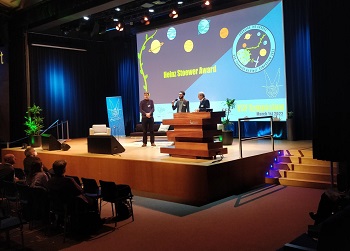(English follows Dutch)
Berend Schuit heeft de Heinz Stoewer Space Award gewonnen voor zijn afstudeerproject over methaanpluimen dat hij als Delftse student bij SRON uitvoerde. De faculteit lucht- en ruimtevaarttechniek van de TU Delft reikt jaarlijks deze prijs uit aan een student die met zijn/haar afstudeerscriptie het hoogste scoort op kwaliteit en maatschappelijke impact. Schuit heeft een machine-learning model gebouwd dat automatisch methaanpluimen identificeert uit data van het Nederlandse ruimte-instrument TROPOMI.
 Methaan is na CO2 het belangrijkste broeikasgas dat door de mens wordt uitgestoten. ‘Een klein deel van de bronnen is verantwoordelijk voor een disproportioneel groot deel van de totale uitstoot,’ zegt Schuit. ‘In de strijd tegen de opwarming van de aarde is het belangrijk te weten waar die grote methaanbronnen zich bevinden.’ TROPOMI levert dagelijks metingen van methaan in de atmosfeer over de hele wereld. Omdat dit ongeveer tien miljoen metingen per dag zijn is het ondoenlijk voor wetenschappers om elke dag de hele wereld handmatig af te speuren naar mogelijke methaanbronnen. Bovendien zijn er verstorende factoren waardoor de gemeten methaanconcentraties niet één op één te vertalen zijn naar emissies. Zo zorgt de wind voor verspreiding van methaanemissies en blokkeren wolken het zicht vanuit de ruimte.
Methaan is na CO2 het belangrijkste broeikasgas dat door de mens wordt uitgestoten. ‘Een klein deel van de bronnen is verantwoordelijk voor een disproportioneel groot deel van de totale uitstoot,’ zegt Schuit. ‘In de strijd tegen de opwarming van de aarde is het belangrijk te weten waar die grote methaanbronnen zich bevinden.’ TROPOMI levert dagelijks metingen van methaan in de atmosfeer over de hele wereld. Omdat dit ongeveer tien miljoen metingen per dag zijn is het ondoenlijk voor wetenschappers om elke dag de hele wereld handmatig af te speuren naar mogelijke methaanbronnen. Bovendien zijn er verstorende factoren waardoor de gemeten methaanconcentraties niet één op één te vertalen zijn naar emissies. Zo zorgt de wind voor verspreiding van methaanemissies en blokkeren wolken het zicht vanuit de ruimte.
Schuit heeft een machine-learning model ontwikkeld om dagelijks wereldwijd methaanpluimen automatisch te detecteren. Daartoe heeft Schuit zijn model getraind om automatisch methaanpluimen te herkennen in de TROPOMI-metingen. ‘Ik heb het model eerst duizend voorbeelden gegeven van methaanpluimen die we handmatig in de data gevonden hebben,’ zegt Schuit. ‘Daarnaast heb ik het model tweeduizend waarnemingen gegeven zonder methaanpluimen. Daardoor leert het model methaansignalen te herkennen. Geen twee pluimen zijn hetzelfde. Door op deze manier kunstmatige intelligentie-technieken toe te passen is het model in staat om toekomstige, nog onbekende methaanpluimen te detecteren op basis van wat het heeft geleerd uit het verleden.’
Door Schuits model is het SRON-TROPOMI team nu beter in staat om automatisch methaanbronnen te detecteren en er onderzoek naar te doen. Ze krijgen nu elke dag een lijst met locaties die hoge emissies laten zien. Schuit: ‘Daar staan bekende bronnen op, zoals de lekkende olie- en gasinstallaties in Turkmenistan, wat betekent dat het model werkt. Maar we zien ook regelmatig nieuwe bronnen. De meest interessante geven we door aan onder andere het team achter de Canadese satelliet GHGSat, die verder inzoomt en zo exact de lekkende methaanbron kan identificeren.’
Schuit is inmiddels ook bij SRON begonnen aan zijn promotieonderzoek, opnieuw onder begeleiding van Bram Maasakkers en Ilse Aben.
Berend Schuit wins Heinz Stoewer Space Award
Berend Schuit has won the Heinz Stoewer Space Award for his graduation project on methane plumes that he carried out as a student at SRON. The Faculty of Aerospace Engineering at TU Delft presents this award annually to the student whose master’s thesis scored highly in terms of quality and social impact. Schuit built a machine-learning model that automatically identifies methane plumes from data collected by the Dutch space instrument TROPOMI.
Methane is the second most important greenhouse gas emitted by humans after CO2. ‘A small part of the sources is responsible for a disproportionately large part of the total emissions,’ says Schuit. ‘In the fight against global warming, it is important to know where these large methane sources are located.’ TROPOMI provides a daily global map of methane in the atmosphere. Because these are about ten million measurements per day, it is impossible for scientists to manually search the entire globe for possible sources of methane. Moreover, there are disturbing factors that make it difficult to translate measured methane concentrations into emissions. For instance, the wind causes methane emissions to spread and clouds block the view from space.
Schuit has developed a machine-learning model to automatically detect methane plumes globally on a daily basis. To this end, Schuit trained his model to automatically recognise methane plumes in the TROPOMI measurements. ‘First I gave the model a thousand examples of methane plumes that we manually found in the data,’ says Schuit. ‘Then I gave the model two thousand observations without methane plumes. This teaches the model to recognise methane signals. No two plumes are the same. By applying these artificial intelligence techniques, the model is able to detect future, still unknown, methane plumes based on what it has learned from the past.’
Thanks to Schuit’s model, the SRON-TROPOMI team is now better able to automatically detect and investigate methane sources. Every day they now receive a list of locations that show high emissions. Schuit: ‘This includes known sources, such as the leaking oil and gas installations in Turkmenistan, which means that the model works. But we also regularly see new sources. We pass on the most interesting ones to, among others, the team behind the Canadian satellite GHGSat, which zooms in further and can thus identify the leaking methane source precisely.
In the meantime, Schuit has started a PhD project, also under supervision of Ilse Aben and Bram Maasakkers.


